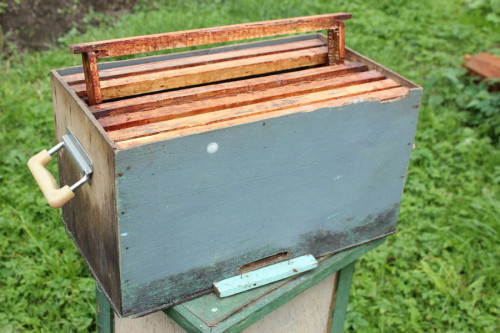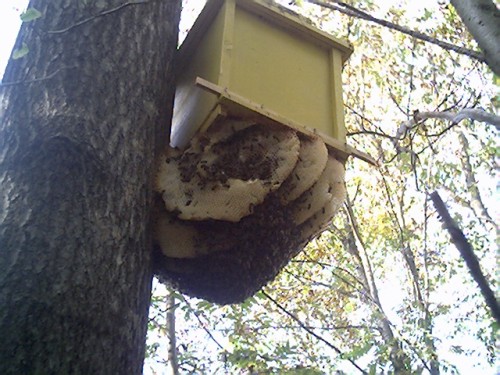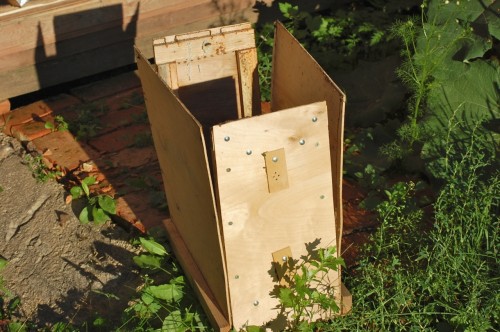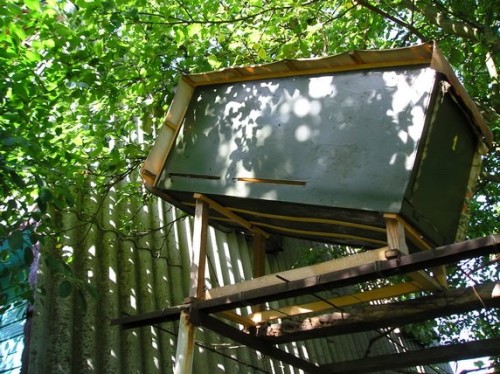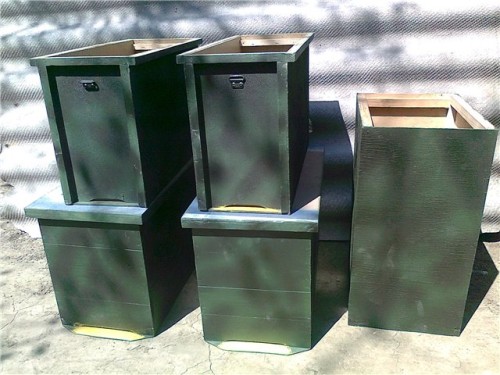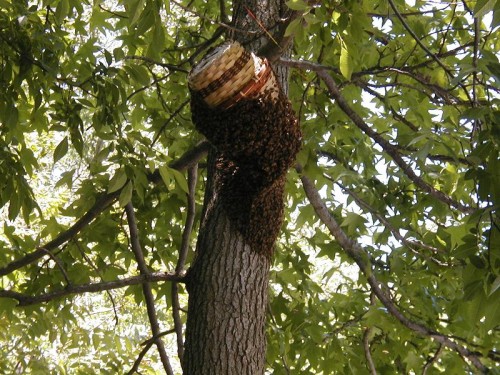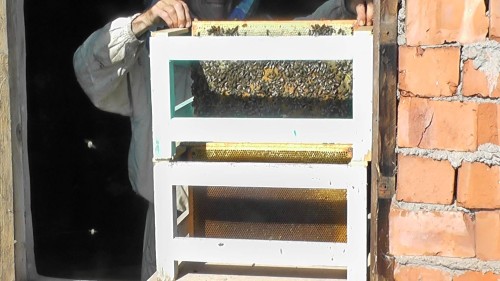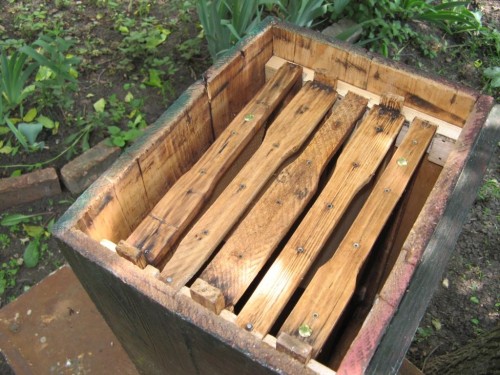It is one of the most effective methods of breeding bees, besides, in the old days this method was the only opportunity to increase the apiece. Based on the conditions of modern beekeeping, honey bees can multiply differently. However, if you want to replenish the number of bee, saving money, then you should learn how to make traps for bees with your own hands. Moreover, for this occupation you will not need any special professional skills. A simple fish tool you can do quickly and easily, putting quite a bit effort.
Content
- How to make a trap for bees
- Some features and requirements for fish guns
- How to make a trap with your own hands: step-by-step process
- Some nuances
- Choosing a place to accommodate trap
- What to do after settling bees?
- Fishing ROEV - benefit for you and for nature
- Trap for bees with your own hands. Video
How to make a trap for bees
By setting this issue, you will find that there are a variety of forms of such traps, and that they can be made from various materials. But this is not important, because for the capture of bees you will need just scrupulously and accurately calculate everything, adhering to the basic rules.
A prepared drawing will be very helpful in this business - a trap for bees, thanks to him, it will turn out to be more thoughtful, as you can take into account all the nuances and do not miss anything.
Some features and requirements for fish guns
Traps for ROOFs Bees are a wooden box with a valve. You can make it from any girlfriend, which are available in your farm: Applying the usual boards, and unnecessary walls (shelves) of cabinets from DVP or chipboard, and slices of thick plywood and so on. Choosing, from which to do the trap, prefer the easiest, affordable and practical materials.
The dimensions of the bees for bees should not exceed 60 liters, as the larger volume is not rational. The most optimal is considered to be a fishing instrument for 40-50 liters - such a trap will become a beautiful house for a full bee family.
The design is best to do vertical, because so bees will be able to take it for the hollow on the tree, and will want to settle there. Be sure to follow the materials that you have chosen for the manufacture of traps for bees, there was no sharp smell. But the bait does not hurt. You can use both a special ointment and a framework with honeycombs or propolis.
Prepare in advance all the necessary tools and materials. If you doubt your abilities, look at the process of creating a trap for bees on video. Step-by-step instructions will help you to do everything as accurately and right.
Tools required for work:
- drill;
- saw;
- hammer;
- chisel;
- drill;
- furniture stapler.
Materials that may need:
- the drawing that you chose or prepared;
- the main material (pay attention to its quality, strength and reliability);
- sufficient stock of nails and wire;
- 4 mm ptyurs;
- 4 mm plywood (thickness);
- the right amount of boards (their thickness should be 20 mm, and width - 200 mm);
- motor rope (no less than 10 m);
- reiki, size of 2 × 2 cm;
- canvas segment (medium size);
- harvested in advance bark of the tree;
- material for protecting (isolation) - polyethylene or rubryoid is suitable. This will help protect the trap from getting cold or moisture;
- glue.
How to make a trap with your own hands: step-by-step process
First of all, you will need to make a hull:
- To do this, take the boards and run them together. So you will have a bottom of the future tools of Lov.
- In the same way, make the back and facade side of the trap.
- In the wall that will be in front of the design, it is necessary to cut a small hole for the pilot (about 1 × 10 cm). Its form can be round, or just make it in the form of a narrow slit, so that without difficulty in the trap, it was able to get the biggest bee, but, at the same time, no other unnecessary liveliness was crawled.
- Now you can fix the finished walls to the bottom.
- Next comes the queue of the frame. For its manufacture you will need rails. Please note that the trigger of longitudinal rails is better for a couple of centimeters below the upper feature. So the top cover, which will be over the edges of the trap, will be established without any problems. This design will serve as a visor on both sides of the trap.
- To cover the side walls, cut out pieces of the desired size from the plywood sheet.
- Do not forget that the sidewalls will need to nose special lumps. Of course, we are talking about the side that will be inside the shaft of the log, because you will put the frames for the bee.
- Collect housing.
The next step is the cover of the lid. Consider that this part of the design should be a similar to the roof of the present full-fledged hive.
- Draw on a sheet of plywood a rectangular part, so that the size of the edges above the body (why - explained above).
- Calculate cut.
- Subscribe with the help of bars of the edge of this rectangle: as a result, it should be perfectly dressed in the body and close it tightly.
- The inner side of the lid is in the foam, and the external top is to use with a polyethylene film or runner.
- Fix the roof on the housing using pins.
- If you want a trap for bees to be convenient to carry, mount on a tree or transport, then make one or two handles on top of the roof. To this end, you can use wire.
Some nuances
After you fully finish the whole design, you will need to put the frame in it. Put several (one or two) frames with old, free honeycombs on the foreground, from which honey pumps. And the rest should be clean with the commodity. Prepare folders in advance to put them there. Optimal is considered when the trap contains from five to eight frames. After installation, cover the canvas frame.
If you want a new home to become more attractive for bees, pull out the walls of the trap with propolis or wax. Some advise them to rub them, as well as the pilot with the help of citrus crust, mint, melt, or basil, as striped workers adore these smells. But it is not necessary to succumb to frequent delusion and leave inside sugar syrup or honey, because so you will rather catch ants than bees.
For the purpose of disguise, you can see the trap also the bark of the tree that you plan to hang it. If you cover the walls of the Olifeau or paint them, then spend all these works in advance before the season of the rod and catching bees, so that the trap is thoroughly ventilated, and all unnecessary and repulsive smells are gone. That is, it is best to do in the fall.
How to make a trap for bees from dvp
Another option of homemade fishing tool is a design of the Fiberboard. For her facilities you will need:
- directly, the material itself;
- olife;
- dark green paint;
- rake (take a 4 cm width, and a thickness of 2.5 cm).
The main list of tools and other necessary things does not change, depending on the different materials, since the technology of manufacturing the trap is the same for all of them.
For convenience, it is best to use the drawing. You can take the basis ready, to fit it under the dimensions you need.
- Cut the blanks for the walls of the design of the WHP sheet according to your drawing.
- Among other things, you will need a folding edge mill. With her you can make a fold-quarter. It will be installed on the rails that you secure at the top of the rear and the facade walls.
- Also reconnect the rails around the perimeter of the rear and front walls.
- Attach to the facade of rear traps and side walls.
- On the facade do not forget to make the flyer.
- Now navigate the side walls on the side walls, remembering the place for landing the roof (the upper place is 4 cm below the edge).
- Make the roof strapping from the rails.
- Drink the ceiling for the roof from the fiberboard. He will not need fasteners.
- Also cut out the roof itself, not forgetting about visors from the rear and the facade.
- Form the finished roof from your items.
- Soak the inside of the bees for bees Olife, and on top (for disguise) cover dark green paint.
- In the end, hang the framework, so that they are placed between the facade and the back wall on Falk-quarter. To make the frames not moved from movement and movement, you can use special wedge-straps or locks-locks.
Choosing a place to accommodate trap
The correct design is only half anteen, because to catch the swarm, you need to advertise my trap yet and competently. If you carefully follow the roces, then nature will tell you the optimal place. With constant observations, you can find that bees most often fly to some one tree. Here and hang the trap. If you did not have to see the places in love with bees, then trust the adopted and verified rules:
- oak, pine, plum, pear, whale, big spruce or aspen are trees that are best suited for folding bait;
- thick pine forests are not suitable, because there is no grass;
- also avoid swampy terrain;
- beware of the poplars, since a whole swarm may die from their fluff;
- in the absence of forests nearby, catch bees on fruit trees, winds or acacias;
- well, if the tree grows on the slope, which leads to the active reservoir (it can be both a small stream and a full-fledged lake or river);
- choose a native tree so that it is beneficial to stand out among the others (see the diameter of the trunk and height);
- do not stop on the tree in the area of \u200b\u200bthe forest. It is better to prefer the place at a distance of about 50-100 m from the edge. Ideally, if the deforestation is located near, a honeybee or a large meadow (other nectar collection places);
- hang the trap at an altitude of three to eight meters;
- to do this, choose a strong large branch so that there were many foliage for sufficient shadow;
- the trap should be located on the south (either southeast, south-west) Letter;
- use the wire to attach to the attachment, and the rope will help you to raise the trap. To do this, just secure it on the handle. Next, throw off the rope through the branch and pull it for a long end, raising your fish tool;
- on the roof you can put a bark of a tree;
- please note that there is no electrolyinium near, while the noise of the car highway or the railway will not affect the bees.
Install a trap a few weeks before the start of the season of the Rotation (the end of May is the beginning of June), that is, in mid-May. The fact is that insects are engaged in the search for new housing in advance, and intelligence bees fly through the counties to look after the place for the roa. Hanging the trap, you can simply check it out. If necessary, the fishing instrument can be heard, or just watch it. If you see that on the front wall, about a dozen bees actively crawls, you can be sure that very soon in the new house will be a full-fledged Roy.
What to do after settling bees?
If you made sure that the trap is populated by ROOM, get ready to remove it and carry bees to a new residence. To do this, carefully take care of the rules and safety techniques. It is best to remove the trap in the evening when all bees end up and hide in the house. Well, if it is cool on the street, so that striped residents do not panic there, because you will have to close the pilot. To this end, it is possible to use pieces of foam rubber or a small-scale kapron mesh, which is attached to the stationery buttons. If the heat is very strong, you have to remove the roof. To do this, reincut the carli of the body along with the lid. And then, weakening a little bit of this dressing, slowly get the lid. So you will provide fresh air bees.
Lower, driving a rope, trap on the ground. Next, try to transport bees for an apiary as soon as possible to settle them already on a permanent place.
By the way, the trap can be used again, even at that very place. Just again soda the front wall from the inside and the flyer with the help of herbs or wax.
Do not forget about security measures: so as not to make any infection or plaque infection or ticks, treat the caught bees against nostectosis or boostose. Other vaccinations are possible.
Fishing ROEV - benefit for you and for nature
Having mastered catching swarms of bees, you will not only be able to constantly update their apiary without any financial cost, but also be of great benefit nature. The fact that a large number of bees swarming at risk and unable to find a suitable home, which means that they do not have time for winter to get the right amount of honey and die.
Therefore, it is worth thinking about such a useful and even profitable case, because it is completely optional to carry traps somewhere far - with proper training you can catch the swarms and on your estate. The main thing is to still follow, so that they do not belong to anyone, because often Roy has its own owner, and just flew away from the neighboring apiary. Then these bees are better to return home and continue to catch further.
Let the catch of Raev are quite painstaking and requiring careful attention to the case, but it will be the acquisition of valuable insects that differ in their performance, resistance to winter conditions and various diseases. Your hives will constantly replenish "fresh blood," which will benefit your beekeeping household.


